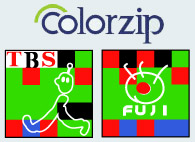ColorZip Partners with TV Broadcasters for Mobile Marketing
 Now that TV viewing has jumped off the couch and onto the streets over wireless handsets, Japanese TV broadcasters are scrambling to adapt content and programming to mobile viewing. Colorzip Japan is introducing a Technicolor technology that could bring TV mobile marketing into focus for broadcasters.
Now that TV viewing has jumped off the couch and onto the streets over wireless handsets, Japanese TV broadcasters are scrambling to adapt content and programming to mobile viewing. Colorzip Japan is introducing a Technicolor technology that could bring TV mobile marketing into focus for broadcasters.
Colorzip Japan recently announced it is working with strategic partners Fuji Television Network, and Tokyo Broadcasting System (TBS) on a late-summer launch of TV applications for its two-dimensional server based code recognition system, ColorCode, linking TV broadcasts to related digital content for sponsored websites, music samples, contests and prize drawings.
The technology could eventually provide easy access to TV programming in progress or rebroadcasts via subscriptions. For now though, the developers are looking at links to mobile program websites as well as contests and promotions. Colorzip Japan CEO Christopher Craney told WWJ, “TV companies are working on this initially as a way to promote their programming.” (Evan Owens, Director and CTO, made a presentation about this technology at Mobile Monday Tokyo’s April Event — Ed.).
Colorzip Japan is the exclusive Japan licensee for ColorCode technology developed by researchers at Korea’s Yonsei University. According to the company, their creation is the first three-dimensional code system to integrate online and offline, analog and digital components. It allows a camera to recognize indexed codes, which are linked to data. The system is already widely used throughout Korea. “URLs link us to everything on the Internet” says Craney. “Think of ColorCode as a URL linking the real world to the virtual world from any physical object, printed material or document.”
Another bar code medium, QR codes by Denso Wave, has become a marketing sensation in Japan. Popping up on print ads, packaging and in magazines QR users take a photo of the code to link automatically or with one-click to a mobile website. ColorCode operates on a similar system but must pass through an intermediary server to access the data. Unlike QR codes, they do not need a sharp clear shot to connect. ColorCode still functions even if damaged, blurred or faded. Comments Craney, “ColorCode is made for less than perfect environments. What sets it apart from QR codes is that the Korean designers basically created it for access from cell phones cameras. That means low speed cameras or low resolution pose no connection problem for users. QR codes, however, were originally envisioned as high-resolution industrial codes with laser readers, not cell phones, in mind.”
While QR codes are an everyman technology, free and easy to produce, Colorzip is concentrating on the corporate market. Both Fuji and TBS reportedly own a little over 18 percent each of Colorzip Japan with individual investments estimated by local media of around 50 million yen. Despite the added issues of an intermediary server, it is easy to see why the broadcasters are willing to invest in this technology. The bright, colorful codes can be redesigned as corporate logos, brand names, characters, almost anything – something QR codes would have difficulty with — plus it works on nearly any surface or media – even T-shirts –or stretched to a range of sizes. The codes can be read by a camera positioned at any angle within 140 degrees (70 degrees to the left and right of center) of the image, even when framed upside down. It works in both Java and brew environments.
The companies server based platform allows it to expand on the codes advertising potential to incorporate music, video and images into promotional websites. Servers track where and when users accessed the website and also build in flexibility to immediately change or update ads/campaigns.
Interactive content, audience participation and user tracking have both retailers and broadcasters considering this new advertising medium. “Advertisers are looking at mobile phones and ColorCode technology as a great way to promote impulse buying and shopping,” says Craney. “But for television companies the mobile phone is a very effective way to improve their dialogue with viewers in what has traditionally not been a very interactive environment.”
Tech developments like ColorZip for wireless TV viewing are being embraced by mobile content creators and marketers and just could change the term ‘active viewing’ from an oxymoron into a reality.
— Gail Nakada
**Update: see we have just posted video interview with demo now online!

